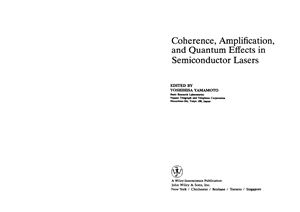Wiley-Interscience, 1991, 646 Pages
This is the first book to review in systematic fashion the coherence, amplification and quantum effects in semiconductor lasers. There are three major sections in the text. The first deals with the application of semiconductor lasers for coherent communication and spectroscopy, outlining the fundamental spectral and modulation characteristics of semiconductor lasers. Semiconductor laser amplifiers, particularly the Fabry-Perot cavity amplifier, traveling wave amplifiers and the injection-locked oscillator, are covered in the second section which serves to point out the advantages and problems of optical amplifier technology. The third section discusses the quantum effects in semiconductor lasers, describing squeezed-state generation and inhibition of spontaneous emission as well as general quantum noise properties. This section also examines new research directions in quantum optics and the potential for a noiseless and thresholdless semiconductor laser.
This book contains 12 review chapters, written by leading scientists in the field, on both classical and quantum aspects of semiconductor lasers and related applications. The first five chapters deal mainly with the classical noise and modulation characteristics of semiconductor lasers. Spectral linewidth broadening and frequency modulation of semiconductor lasers have been extensively studied during the last 10 years because of their potential technological importance for coherent communications and laser spectroscopy. The next three chapters deal with optical signal amplification in semiconductor lasers. Nearly all have been conceed with linear amplifiers operating below the oscillation threshold, but nonlinear injection- locked oscillators operating above the oscillation threshold have also attracted attention. The final four chapters deal with the quantummechanical (nonclassical) aspects of semiconductor lasers. A squeezed state with quantum noise reduced to below the standard shot noise limit can be generated and spontaneous emission can either be inhibited or enhanced in microcavity semiconductor lasers.
This is the first book to review in systematic fashion the coherence, amplification and quantum effects in semiconductor lasers. There are three major sections in the text. The first deals with the application of semiconductor lasers for coherent communication and spectroscopy, outlining the fundamental spectral and modulation characteristics of semiconductor lasers. Semiconductor laser amplifiers, particularly the Fabry-Perot cavity amplifier, traveling wave amplifiers and the injection-locked oscillator, are covered in the second section which serves to point out the advantages and problems of optical amplifier technology. The third section discusses the quantum effects in semiconductor lasers, describing squeezed-state generation and inhibition of spontaneous emission as well as general quantum noise properties. This section also examines new research directions in quantum optics and the potential for a noiseless and thresholdless semiconductor laser.
This book contains 12 review chapters, written by leading scientists in the field, on both classical and quantum aspects of semiconductor lasers and related applications. The first five chapters deal mainly with the classical noise and modulation characteristics of semiconductor lasers. Spectral linewidth broadening and frequency modulation of semiconductor lasers have been extensively studied during the last 10 years because of their potential technological importance for coherent communications and laser spectroscopy. The next three chapters deal with optical signal amplification in semiconductor lasers. Nearly all have been conceed with linear amplifiers operating below the oscillation threshold, but nonlinear injection- locked oscillators operating above the oscillation threshold have also attracted attention. The final four chapters deal with the quantummechanical (nonclassical) aspects of semiconductor lasers. A squeezed state with quantum noise reduced to below the standard shot noise limit can be generated and spontaneous emission can either be inhibited or enhanced in microcavity semiconductor lasers.

